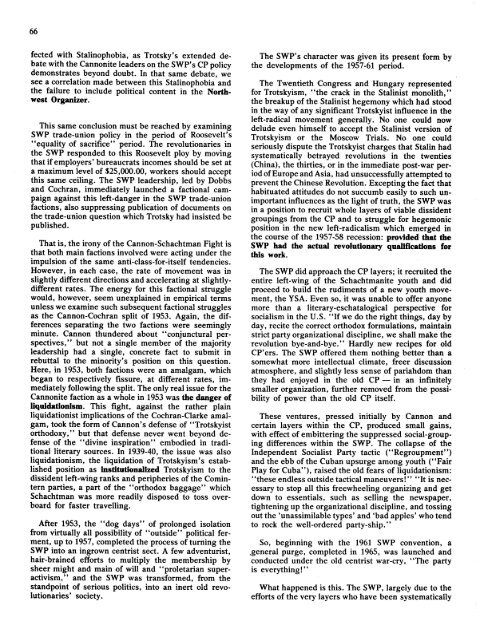New Left, Local Control, and Fascism
New Left, Local Control, and Fascism
New Left, Local Control, and Fascism
Create successful ePaper yourself
Turn your PDF publications into a flip-book with our unique Google optimized e-Paper software.
66<br />
fected with Stalinophobia, as Trotsky's extended de- The SWP's character was given its present form by<br />
bate with the Cannonite leaders on the SWP's CP policy the developments of the 1957-61 period.<br />
demonstrates beyond doubt. In that same debate, we<br />
see a correlation made between this Stalinophobia <strong>and</strong> The Twentieth Congress <strong>and</strong> Hungary represented<br />
the failure to include political content in the North. for Trotskyism, "the crack in the Stalinist monolith,"<br />
west Organizer. the breakup of the Stalinist hegemony which had stood<br />
in the way of any significant Trotskyist influence in the<br />
left-radical movement generally. No one could now<br />
This same conclusion must be reached by examining delude even himself to accept the Stalinist version of<br />
SWP trade-union policy in the period of Roosevelt's Trotskyism or the Moscow Trials. No one could<br />
"equality of sacrifice" period. The revolutionaries in seriously dispute the Trotskyist charges that Stalin had<br />
the SWP responded to this Roosevelt ploy by moving systematically betrayed revolutions in the twenties<br />
that if employers' bureaucrats incomes should be set at (China), the thirties, or in the immediate post-war pera<br />
maximum level of $25,000.00, workers should accept iod of Europe <strong>and</strong> Asia, had unsuccessfully attempted to<br />
this same ceiling. The SWP leadership, led by Dobbs prevent the Chinese Revolution. Excepting the fact that<br />
<strong>and</strong> Cochran, immediately launched a factional cam- habituated attitudes do not succumb easily to such unpaign<br />
against this left-danger in the SWP trade-union important influences as the light of truth, the SWP was<br />
factions, also suppressing publication of documents on in a position to recruit whole layers of viable dissident<br />
the trade-union question which Trotsky had insisted be groupings from the CP <strong>and</strong> to struggle for hegemonic<br />
published, position in the new left-radicalism which emerged in<br />
the course of the 1957-58 recession: provided that the<br />
That is, the irony of the Cannon-Schachtman Fight is SWP had the actual revolutionary qualifications for<br />
that both main factions involved were acting under the this work.<br />
impulsion of the same anti-class-for-itself tendencies.<br />
However, in each case, the rate of movement was in The SWP did approach the CP layers; it recruited the<br />
slightly different directions <strong>and</strong> accelerating at slightly- entire left-wing of the Schachtmanite youth <strong>and</strong> did<br />
different rates. The energy for this factional struggle proceed to build the rudiments of a new youth movewould,<br />
however, seem unexplained in empirical terms merit, the YSA. Even so, it was unable to offer anyone<br />
unless weexamine such subsequent factional struggles more than a literary-eschatalogical perspective for<br />
as the Cannon-Cochran split of 1953. Again, the dif- socialism in the U.S. "If we do the right things, day by<br />
ferences separating the two factions were seemingly day, recite the correct orthodox formulations, maintain<br />
minute. Cannon thundered about "conjunctural per- strict party organizational discipline, we shall make the<br />
spectives," but not a single member of the majority revolution bye-<strong>and</strong>-bye." Hardly new recipes for old<br />
leadership had a single, concrete fact to submit in CP'ers. The SWP offered them nothing better than a<br />
rebuttal to the minority's position on this question, somewhat more intellectual climate, freer discussion<br />
Here, in 1953, both factions were an amalgam, which atmosphere, <strong>and</strong> slightly less sense of pariahdom than<br />
began to respectively fissure, at different rates, im- they had enjoyed in the old CP- in an infinitely<br />
mediately following the split. The only real issue for the smaller organization, further removed from the possi-<br />
Cannonite faction as a whole in 1953 was the danger of bility of power than the old CP itself.<br />
llquldationism. This fight, against the rather plain<br />
liquidationist implications of the Cochran-Clarke areal- These ventures, pressed initially by Cannon <strong>and</strong><br />
gam, took the form of Cannon's defense of "Trotskyist certain layers within the CP, produced small gains,<br />
orthodoxy," but that defense never went beyond de- with effect of embittering the suppressed social-groupfense<br />
of the "divine inspiration" embodied in tradi- ing differences within the SWP. The collapse of the<br />
tional literary sources. In 1939-40, the issue was also Independent Socialist Party tactic ("Regroupment")<br />
liquidationism, the liquidation of Trotskyism's estab- <strong>and</strong> the ebb of the Cuban upsurge among youth ("Fair<br />
lished position as institutionalized Trotskyism to the Play for Cuba"), raised the old fears of liquidationism:<br />
dissident left-wing ranks <strong>and</strong> peripheries of the Comin- "these endless outside tactical maneuvers!" "It is nectern<br />
parties, a part of the "orthodox baggage" which essary to stop all this freewheeling organizing <strong>and</strong> get<br />
Schachtman was more readily disposed to toss over- down to essentials, such as selling the newspaper,<br />
board for faster travelling, tightening up the organizational discipline, <strong>and</strong> tossing<br />
out the 'unassimilable types' <strong>and</strong> 'bad apples' who tend<br />
After 1953, the "dog days" of prolonged isolation to rock the well-ordered party-ship."<br />
from virtually all possibility of "outside" political ferment,<br />
up to 1957, completed the process of turning the So, beginning with the 1961 SWP convention, a<br />
SWP into an ingrown centrist sect. A few adventurist, .general purge, completed in 1965, was launched <strong>and</strong><br />
hair-brained efforts to multiply the membership by conducted under the old centrist war-cry, "The party<br />
sheer might <strong>and</strong> main of will <strong>and</strong> "proletarian super- is everything!"<br />
activism," <strong>and</strong> the SWP was transformed, from the<br />
st<strong>and</strong>point of serious politics, into an inert old revo- What happened is this. The SWP, largely due to the<br />
lutionaries' society, efforts of the very layers who have been systematically

















